#Taruca
Explore tagged Tumblr posts
Text


3 notes
·
View notes
Text

Drawing Deer Species 38/50
Taruca
This South American deer has only two tines on it's antlers even fully grown, and it's location in the Andes Mountains combined with it's large fluffy body make it look similar to an alpine-enjoying antelope.
Males tend to have a distinctive black mask of pigment with a V-shape mark going down it's snout. Males also have sharp canine teeth.
Taruca enjoy high altitudes and the patchy grasses and shrubs that grow there. When they do descend from the mountains they may intermingle with the whitetail deer of Peru, but they rarely ever go lower then 4,000ft elevation.
These deer like to socialize with others but don't stick in specific herds, changing between groups as they please. These groups are not separated by sex, unlike several other deer species.
3 notes
·
View notes
Photo

Taruca Hippocamelus antisensis
Observed by larsonek, CC-BY-NC
7 notes
·
View notes
Text



another pile of sketches from the discord that i haven't stuck here yet!! featuring some old railway reincarnation au memes, a sonny, nine and sybilla having a race, nine being rudely awoken, gord and scotty having a nice time for once, douglas and oliver being silly, and my newbie ocs in their romance arc!
#konnocharacters#konnodoodle#art#railway reincarnation au#ttte#ttte art#ttte fanart#ttte memes#thomas and friends#tidmouth sheds#ttte oliver#ttte sonny#ttte arthur#ttte thomas#ttte douglas#ttte gordon#ttte flying scotsman#ttte oc churchward#ttte oc nine#ttte oc sybilla#ttte oc peggy#ttte oc jaybird#ttte oc taruca 61116#ttte oc taruca 73156#douglasxoliver#peggyxsybilla#tarucaxtaruca
79 notes
·
View notes
Text
New Playlist - The Cervid Bin
The Cervid family includes deer, moose, elk and more!
#cervidkin#deerkin#elkkin#moosekin#Chitalkin#muntjackin#Reindeerkin#pudúkin#brocketkin#Tarucakin#cervid therian#deer therian#elk therian#moose therian#chital therian#muntjack therian#reindeer therian#taruca therian#pudú therian#brocket therian#cervidhearted#deerhearted#elkhearted#moosehearted#chitalhearted#muntjackhearted#reindeerhearted#pudúhearted#brockethearted#tarucahearted
1 note
·
View note
Text
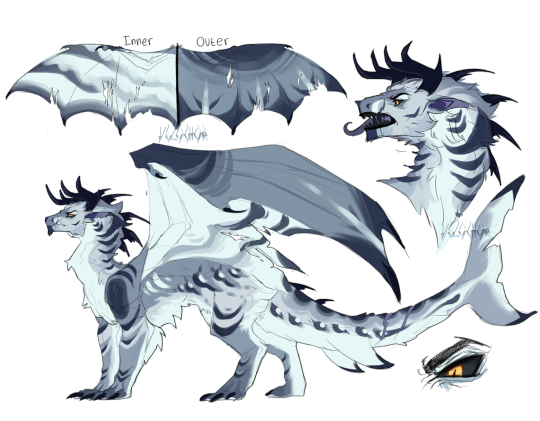
Grarrrr this app is super cute first post or whatever
Ref of my pookie sona 😈😈😛😼 Taruca
36 notes
·
View notes
Text


In the very beginning stages of reworking the stuff I made for/care about from Kingdom Hearts into my own thing, starting with our protags, Eve and Owen. Eve is a Taruca deer, Owen is a Maine Coon. The setting is low tech/high fantasy type deal, little bit of western in the mix
#Cheri Art#OC#Lady Evelynn#Cap'n Owen#Prosparadi Story#temp name for now til i think of smth better#unlike the source material tho Owen is gonna end up as more of an anti-hero than a jerk turned villain like the source material character#but thats after a 15 year timeskip
11 notes
·
View notes
Text
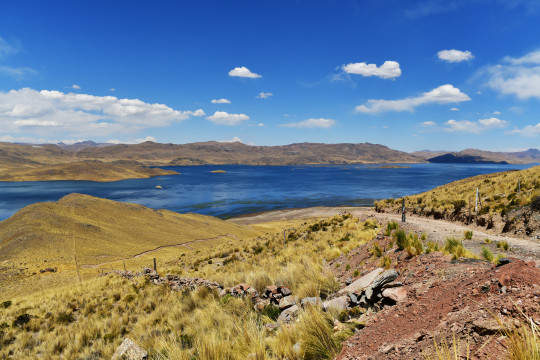
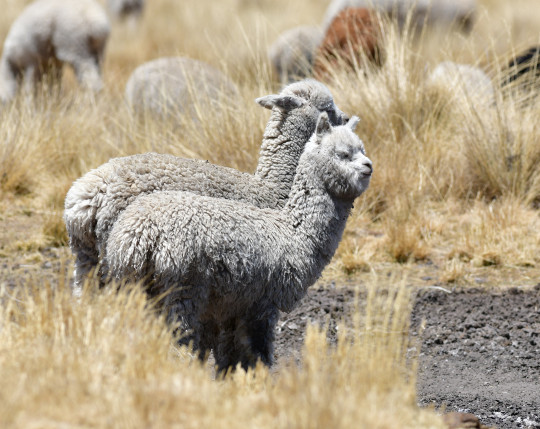

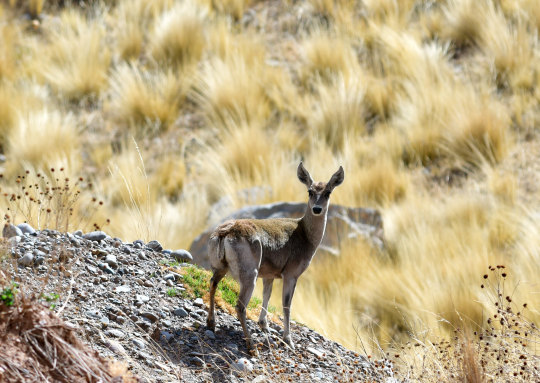

The Altiplano (2) (3) (4) (5) by Panegyrics of Granovetter
Via Flickr:
(1) (5) Lagunillas lake. (2) Fluffy alpacas. (4) A roadside sighting of a taruca, an elusive north Andean deer species.
30 notes
·
View notes
Text
Unnecessary otherkin sideblog, main is sirenium (link)
basics: I support contradictory labels, endo systems, etc. I am queer and neurodivergent. Before you come after me for my username, I am intersex and reclaim the h-slur. More on my identity outside of alterhumanity is in my main's pinned post.
Why did I make this blog? So I can have a blog for purely otherkin related content. I may still use the other one for this stuff as well. Now with that out of the way, it's time for the comically long explanation of my alterhuman identity, featuring every single creature that I have been connected to at one point or another.
I am a polymorph, which causes my kintype list to look like this as a lot of these are forms: Borzoi, Border collie, Blue brindle pit bull, Coyote, Coastal wolf, Doberman, Dhole, German shepherd, Ibizan hound, Maned wolf, Norwegian elkhound, Silken windhound, Werewolf, Asian golden cat, Bombay cat, Bengal tiger, Black footed cat, Cougar, Cheetah, Oriental shorthair, Ocelot, Serval, Sphinx, Basking shark, Bull shark, Black-tipped reef shark, Greenland shark, Lemon shark, Leopard shark, Whale shark, Chital deer, Caribou deer, Sika deer, Taruca deer, Thorold's deer, White tail deer, Alternate (Mandela Catalogue), Bearded vulture, Black bear, Bracken (Lethal Company),Coconut octopus, Golden-capped fruit bat, Genet, Giant isopod, Incubus, Irken (Invader Zim), Kitty (Backrooms), Lynel (Legend of Zelda), Leafeon (Pokemon), Loot bug (Lethal Company), Naegleria Fowleri (commonly: brain eating amoeba), Orca, Opossum, Rook, Raccoon, Sylveon (Pokemon), Striped hyena, Spotted hyena, Vampire, Vulture bee, and Zonai (Legend of Zelda: Tears of The Kingdom).
again, a lot of these are simply forms I have taken, though others stick with me more than a face I will occasionally wear. For example, when I say I'm canine therian my mind always goes to being a doberman and a german shepherd, occasionally a coyote or a maned wolf. That does not mean I do not see myself in the others, it only means that those seem to be the most prevalent.
I am a polymorphic god specifically, meaning my polymorphism and godhood are linked. In fact, I am a god of polymorphism. As for being a vampire, my vampirism feels physical and as though it has very much carried over into this body. These things are part of my base identity as nonhuman, and so is being canine therian. As you can probably guess, my alterhumanity is highly complicated and often confusing, as I'll feel like, say, a bearded vulture one moment and a cheetah the next. It can feel unstable and chaotic. I don't have the luxury of a more stable and simple nonhuman identity, nor do I really want to. Because in finding this chaos, I have found myself.
yeah. anyways no DNI but I block literal bigots and assholes here for the sole purpose of being assholes at light speed.
#otherkin#alterhuman#nonhuman#physical alterhumanity#introduction post#canine therian#vampire kin#polymorph kin#god kin#divine kin
15 notes
·
View notes
Text


3 notes
·
View notes
Text


Taruca - friends OC
#painting#art#artists on tumblr#illustration#drawing#digital art#sketch#artwork#design#creative#original art#dragon art
3 notes
·
View notes
Text
one of my all time fav animals .... my favourite deer EVER theyre so lovely and my godddd that photo is gorgeous

Huemul Hippocamelus bisulcus
Observed by tucuquere, CC BY-NC
#taruca#south andean huemul#south andean deer#guemal#huemul#Hippocamelus bisulcus#they have a variety of names !!!! love them#Cervidae#deer#South America#Chile#best cervid ever
106 notes
·
View notes
Note
I think you're most like the taruca deer
Ooooh the Peruvian one? Let's see here...


They're adorable 🥺🥺🥺 definitely a contender, tho I'm not sure it checks all my cervine boxes~ those antlers are teensy n cute thoooo
Which Deer Am I?
1 note
·
View note
Text
Taruka (Hippocamelus antisensis) buck near Puina. by Mónica San-Cristóbal of Asociacion Armonia
33 notes
·
View notes
Link
I’ve got a couple of Faun adopts up over on DA - click the link to take a look :D
3 notes
·
View notes
Text
Huascarán National Park- Cordillera Blanca

Situated in the Cordillera Blanca, the world's highest tropical mountain range, Mount Huascarán rises to 6,768 m above sea-level. The deep ravines watered by numerous torrents, the glacial lakes and the variety of the vegetation make it a site of spectacular beauty. It is the home of such species as the spectacled bear and the Andean condor.
Cordillera Blanca
Mountain range in Peru

Beauty of mount Huandoy, Cordillera Blanca, Ancash, Peru
The Cordillera Blanca is a mountain range in Peru that is part of the larger Andes range and extends for 200 kilometres between 8°08' and 9°58'S and 77°00' and 77°52'W, in a northwesterly direction. It includes several peaks over 6,000 metres high and 722 individual glaciers.
Elevation: 6,768 m, Highest point: Huascaran, Mountain range: Andes, Country: Peru, Length: 180 km (110 mi) N-S, Coordinates: 9°07′17″S 77°36′32″W / 9.12139°S 77.60889°W, Region: Ancash
Huascarán National Park

Mount Huascarán, landmark and namesake of Huascarán National Park
Huascarán National Park (Spanish: Parque Nacional Huascarán) is a Peruvian national park that comprises most of the mountain range known as Cordillera Blanca (the world's highest tropical mountain range) which is part of the central Andes, in the region of Ancash. The park covers an area of 340,000 hectares (840,000 acres) and is managed by the Peruvian Network of Protected Natural Areas, or SERNANP (Servicio Nacional de Áreas Naturales Protegidas). It was designated as a World Heritage Site in 1985 by UNESCO, is also a well-known mountaineering spot, and harbors a unique biodiversity with plant species such as the Queen of the Andes, trees of the genera Polylepis��and Buddleja, and animals such as spectacled bears, condors, vicunas, and tarucas.
Huascarán National Park - Wikipedia



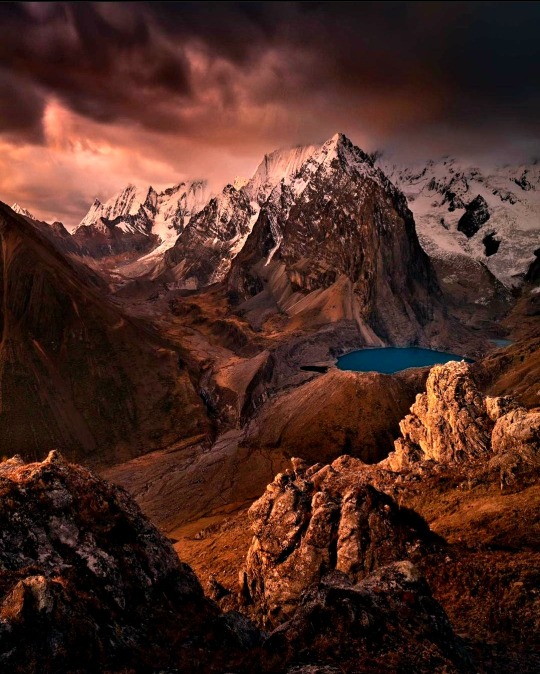
Huascaran National Park, Cordillera Blanca, Peru
76 notes
·
View notes
